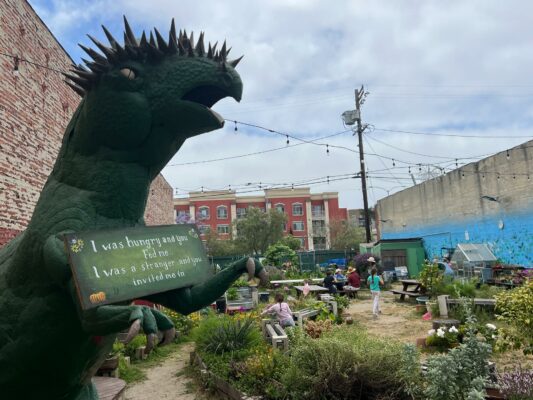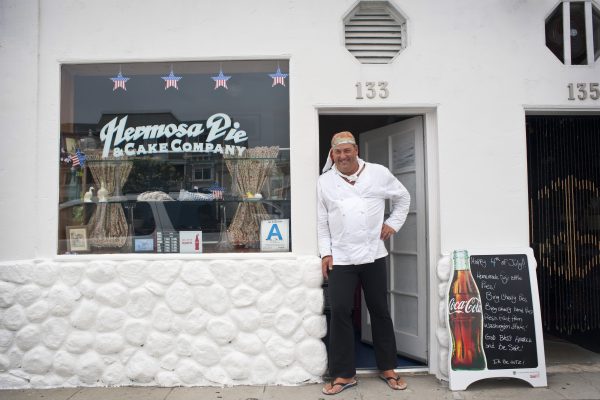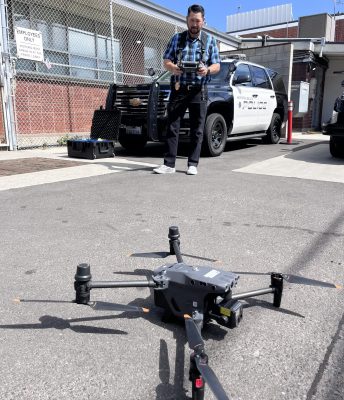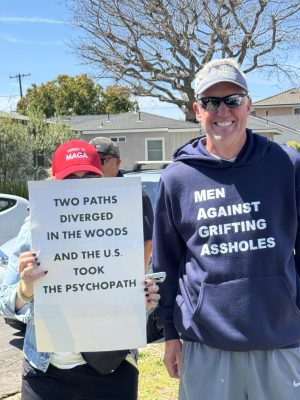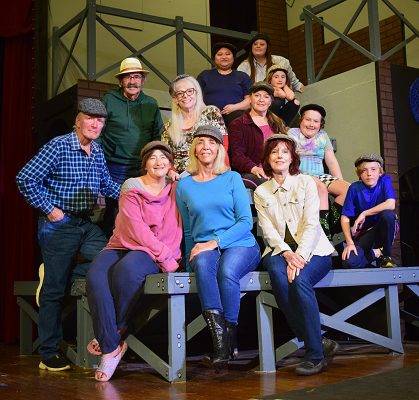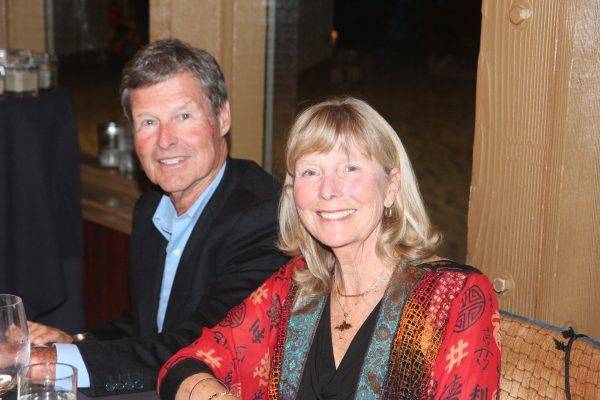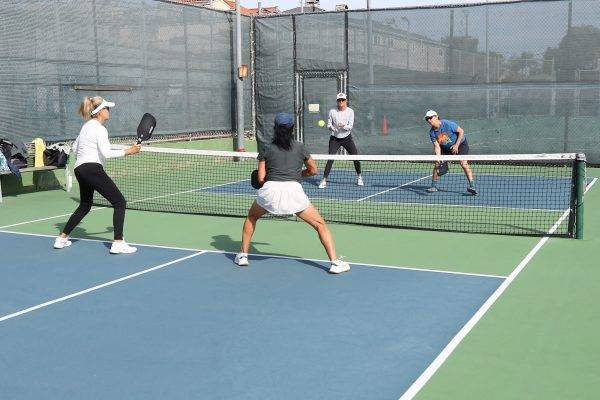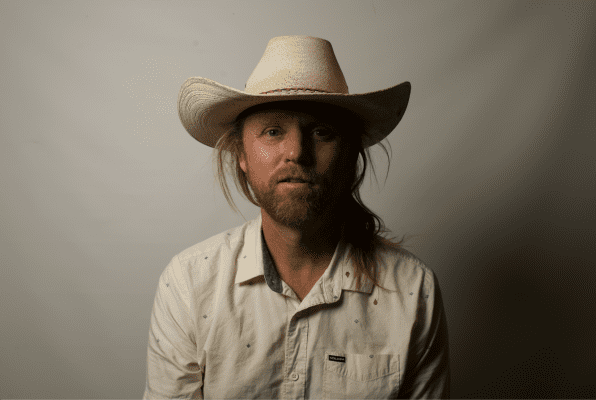After three decades serving South Bay birders, Bob Shanman has closed Wild Birds Unlimited. But he’s not retired from birding
by Bondo Wyszpolski
This is a story about a shop that’s closed and a store owner who’s retired, but of course there’s more to it than that. Both the man and the store had a great impact on the Beach Cities, an impact that is still felt and whose influence will continue to resonate.
This past summer, with subdued fanfare, Bob Shanman closed Wild Birds Unlimited, a business he’d run for more than a quarter of a century, first in Torrance and later in Redondo Beach. Items for sale included bird food, bird feeders, and bird baths. My first thought was that, like so many shops and restaurants, it was another casualty of the pandemic. Well, it was briefly, but soon business again took wing.

“The store was closed to physical traffic for five months,” Shanman says, over coffee at Manhattan Village, “but we continued to serve the communities with phone orders and online orders. Sometimes we were shipping 20, 25 packages in a day or we were doing curbside pickups. Gradually, in August of 2020, we started letting in customers by appointment, and then 2021 turned out to be a record year for us. So in 2020 we maintained our own and saw over 40 percent growth the following year.”
In other words, people didn’t skimp on bird supplies and other related items, whether for birds in the wild or birds in the home. Still, Shanman wanted to sell it.
“The time had come to retire,” he says. “We’d made a family decision that we weren’t going to renew the lease so that I could retire.”
Now let’s rewind and go back several years.

The bird is the word
“The way I got started with the store,” Shanman says, “I had been downsized after 23 years with a company and I was going through a midlife situation of not knowing what I wanted to do. I was out on the Ballona Wetlands and birding — which by the way is my favorite place to go birding — and I had a vision. That vision was that I could not go back into engineering, and that I had to find a job that involved birds, kids, nature, education, photography, and the environment. Three months later I saw an ad in one of the birding magazines for Wild Birds Unlimited franchises. That was on January 7, 1995, and on September 9, 1995, we opened the store. Nine months… a perfect gestation period.
“It was a great organization to be involved with,” he continues. “I have a friend who’s a very well known birder who feels that Wild Birds Unlimited as a system of over 350 stores does more for birds than any organization other than Ducks Unlimited, because we’re in contact daily with people who are providing supplemental food sources for birds, which helps those populations in people’s backyards, literally.”
You’re retired, but not officially retired in the sense that you’re still active in the birding community. Which organizations are you involved with and plan to continue with?
“First and foremost is the Friends of Ballona Wetlands; it’s the first place my wife took me birding back in 1977. I can remember the first bird and exactly where we saw it. It was a Western tanager on one of the fences around one of the old gas wells down there.
“Also I’ll be doing things probably indirectly with the Friends of Madrona Marsh. I’ll continue to do programs with Palos Verdes South Bay Audubon, and I’ll be leading walks with the Palos Verdes Land Conservancy.” In short, “All the organizations that I’ve been involved with for the past 28 years.
“I will not only continue to support them, but hopefully get more active with them, because they’re all focused on protecting the environment and helping the birds.
“One of the reasons I felt the store was so important to birds,” Shanman points out, “was that research showed that birds provided with supplemental food sources, i.e., backyard bird feeding, have strong populations, produce more young, and their general health is better than birds that are totally wild. That’s important because, in my mind, keeping the bird population up and healthy helps to control insects in the world.
“A world without birds is going to be a world overrun by insects, because so many of the birds eat insects. There’s one study done by Dr. Doug Tallamy in Pennsylvania that shows that to raise a brood of black-capped chickadees takes six to nine thousand caterpillars (or from 350 to 570 each day).” And you thought parenting was hard!

Out of the nest
Bob Shanman is a native Angeleno, born in 1945. “I went through the L.A. City School system,” he says, “graduated from Hamilton High in ‘62, went to the U.S. Naval Academy for two years, came back, and graduated twice from UCLA with Bachelor’s and Master’s degrees in Engineering. I was in private consulting engineering for 28 years, and during that time I got married.
“My wife had finished her Master’s degree but she’d always been interested in birds and took a class at UCLA, taught by Arnold Small. A year later when we were remodeling the house she said, ‘I need to get you away from the house; you ought to take [Small’s] class with me this year.’”
In 1977, Shanman did just that, and contracted what we’ll call bird fever. “You can treat the symptoms,” he says, “and treating the symptoms gets you out into nature. And I just fell in love with the hobby.
“We kept taking Arnold’s class and after two years he called us up one evening and told my wife and I not to take the class anymore because we needed to get out on our own and grow — he wasn’t going to be able to take us any further in the class.” That was in 1979, and “we were out birding almost every weekend somewhere in Southern California.”
In 1980, Shanman became involved with the Audubon Society. “One thing led to another and I became president of Los Angeles Audubon in 1982. I’d started leading walks every month at the Ballona Wetlands, and did that for 40 years, one day a month, until the pandemic came along. Now that I’m retired I’m hoping to get those walks restarted.”
From this I’m sure that Shanman can recommend a few places in the South Bay for birdwatching.

“Any park can be good,” he says. “I talk a lot about Polliwog Park in Manhattan Beach. People look at it as a wonderful suburban park, but when I look at it I don’t see a park, I see the pieces that make up the park. We’ve got a microforest in there, we’ve got a meadow, a riparian habitat down by the lake, open water, a little marshy area on the edge of the lake, and up above the pool, where the dog-walk is, there’s another microforest area. Then you get into a dry upland habitat in the Manhattan Beach Botanic Garden.
“In 2007,” Shanman continues, “I started birding the park every week with a friend of mine, Julie Gonella, and we also put out a call to the birding community for people to submit their historic findings to a program through Cornell University called eBird. We have now documented 172 species of birds that have been seen either in or from Polliwog Park. That’s two percent of the world’s birds that have been seen there.”
What are some of the more unusual birds that you’ve seen in the park?
“Almost every winter now we’ll get some (American) white pelicans in Polliwog. The water is attractive to things like that. Mergansers, a type of duck, have been seen there. Peregrine falcons, red-tailed hawks, Cooper’s hawks are resident there. You just never know what’s going to fly by, so it’s really a great place.
“Another wonderful place is Madrona Marsh. It’s so peaceful inside the Marsh and it’s a jewel in the City of Torrance.” He mentions the harbor area and Cabrillo Beach, and walking out on the fishing piers. “You can see what’s in the harbor, especially during the winter when the loons and the sea ducks are down there. Birds are everywhere, on all seven continents. Anywhere you go in the world, if you’re a birder, there’s a place to see birds.”
Birds of a feather…
Specifically, what about the Peninsula.
“Palos Verdes is just covered with good areas to see birds,” Shanman says, and one may think first and foremost of the South Coast Botanic Garden. “Alta Vicente, by the RPV City Hall, is great. Point Fermin is really interesting because a lot of birds of prey surprisingly come in there, plus you can see birds offshore. Long Point is a place where we like to go birding, seabirding, because it juts out and on clear days gives us good open views of the water. The old Forrestal quarry up by Ladera Linda Park off of PV Drive South is another good place, and Malaga Cove has turned out to be a really good area.
“During the annual Christmas count,” he adds, “the area that I do is behind the gates on Crest Road and down into some of the canyons. There’s one particular home that we go to. We’ve probably seen 25 or 30 species in their yard over the years. It’s just a really good confluence of manmade habitat, natural habitat, the topography; everything is just right for lots and lots of birds to come up to their house. Anybody who lives on a canyon has the same situation as they do because if you provide that supplemental food source birds will come up from the canyon and into the yard. It can really be spectacular.”
Have there been invasive species that have altered the bird population in the South Bay?
“That’s an interesting question,” Shanman replies. “There’s two that come to mind. One is the scaly-breasted munia that has established itself in Los Angeles. It’s originally from Southeast Asia. There’s another bird, the pin-tailed whydah (an immigrant itself), and the whydah is what we call parasitic: It will lay its eggs in the nests of other birds and let the other birds raise their young. But in Los Angeles the pin-tailed whydah predates the scaly-breasted munias. So here we’ve got a bird from South Africa and a bird from Asia that are in conflict with each other.
“The English, or house sparrow, a bird from Southeast Asia, is very aggressive. It was brought to Europe by traders along the Silk Highway and, when they were released, populated Europe and got to England. Somebody wanted to save all the birds in Shakespeare’s plays and they brought the house sparrow to the United States. In Los Angeles, in the West, it has pushed house finches out of the picture, in part. But their population is now declining and the house finches are doing just fine.”
I’m sure as time goes on there’ll be more instances of one bird population affecting another.
Shanman agrees and says, “We think this is due almost entirely to climate change. Climate change has affected ocean food resources, and there’s a group of birds called boobies. We have masked boobies, brown boobies and blue-footed boobies. These are tropical birds, now nesting off of Santa Cruz Island. It’s very shocking that they’ve come several thousand miles north of their normal breeding areas.”
Do you see a large difference in the bird population from the time you first began birdwatching as opposed to the present?
“Well, yes,” Shanman says. “The answer is that they’ve been huge changes. And we now know that since 1970 there are three billion fewer adult birds. And we’ve seen birds disappear. The loggerhead shrike used to be low in numbers but a common occurrence in the winter down here. Finding the loggerhead shrike is now exciting. When we first started birding, finding a Cassin’s kingbird was exciting — now it’s found here all year round. Brewer’s blackbirds disappeared for years, but they seem to be coming back over the last couple of years.”
In the past, it was a treat to encounter the Allen’s hummingbird, whereas the Anna’s hummingbird was everywhere. “Now the Allens’ hummingbirds have been so successful that they’ve pushed many of the Anna’s hummingbirds out of the region. They’re the two resident species of hummingbirds, but they’ve switched their relationship with the Allen’s now being the more dominant species. So, yeah, we’ve seen a lot of changes.”

Bob Shanman takes flight
What are some of your more interesting bird stories, especially in the South Bay?
“One of the more interesting stories,” Shanman says, “is that birders keep lists of the birds that they see. There’s the old saw that there’s honor among thieves, so, when you’re keeping [track of your sightings] you want to truly see the bird in the wild.
“We live in Manhattan Beach,” Shanman continues, “and one Saturday afternoon we got a phone call. Somebody had found a bird at the corner of 36th and Laurel Ave, near where we live.” The bird was taken to Shanman’s store, after which he contacted South Bay Wildlife Rehab, who sent someone over to pick it up, to examine it, and to nurse it back to health if necessary.
“It turned out to be a yellow-billed cuckoo. The only place where yellow-billed cuckoos nest in California, that I’m aware of, is at Lake Isabella. It was the year they had the big fire up at Lake Isabella. The bird fled the fire and didn’t stop flying until it was exhausted — and that happened to be at 36th and Laurel. When we brought it to the store it was still alive on Saturday, but overnight it died because it was emaciated. It had migrated about a month too early and it wasn’t ready to go. That was one of the more memorable stories.”
You’ve been to other countries to go birdwatching. What would be some of the more interesting birds that you saw?
Shanman laughs. “They’ve all been interesting in their own way. Our most recent overseas trip was to Cape Town, South Africa, and up to Botswana and Zimbabwe. We saw 200 species of birds in two weeks. Probably the one that would emotionally draw people would be the African penguin in Simon’s Town on the Cape. A funny story with that; there are signs in the parking lot that say, ‘Please check under your car before backing out,’ because penguins will get underneath the car. We can’t go into their space, but they can come into ours.
“We’ve birded in Eastern Europe, Britain, a number of places in Canada, and then in Australia.”
I’m sure you see a whole different subset of birds on each of the continents you visit.
“Absolutely. There are really spectacularly-colored birds in Costa Rica, and loud. They have to communicate in the jungle, so they tend to be on the loud side. But it’s nice because it helps you find them”
What’s your favorite Alfred Hitchcock film?
Shanman isn’t fooled by this question. “It’s not ‘The Birds,’” he says, and we laugh. “I’ve had people tell me that they didn’t like birds because of that movie.”
Bye Bye Birdie
So, after 28 years of running Wild Birds Unlimited, what was it like on the last day, saying goodbye to your store?
“It was sad, but also a relief to know that I wasn’t going to have to be running a business any longer.
“On the morning we opened,” Shanman recalls, “at five minutes to 10, I kicked everybody out of the store,” and then he and a handful of others went outside and across the road. “At one minute to 10, I gave my son the key — he was just short of 11 at that point — and said, ‘Okay, open the store.’ And he walked back across the street, unlocked the door, went in, and turned on the Open sign. And that was how we opened.
“Two weeks before we closed the store I called up my son: ‘If you’re here on the 31st you’ve got to come down and lock the store when we close.’ Unfortunately, he was on a business trip in New Orleans and couldn’t make it. But he said for sure he would have been there had he been in town.” Shanman pauses. “It would really have been kind of neat, just for family history, that we bookended it that way. But we quietly closed. I turned to everybody in the store and said, ‘Whoo-hoo, I’m retired!’”
Thus came the end of an era, for which Bob Shanman remains grateful.
“I would like to thank the thousands of people who supported us over the 28 years. It got to the point early on where I realized we didn’t have customers, we had family and friends. Somebody came in on July 22 who was also there on Sept. 9, 1995 — so I had customers who had been coming in for 28 years. I think that speaks to both the quality of the product that we provided and the quality of the staff we had. Over the years I had great people working for me. So thank you to everybody in the South Bay for supporting us.”
If they could speak, the birds themselves might have flown down from the skies to express their appreciation as well, for weren’t they the true beneficiaries of Wild Birds Unlimited?
For those wishing to contact Bob Shanman, he’s at wburedondo@gmail.com.


